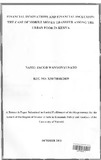| dc.description.abstract | The main objective of this paper was to examine the factors determining access to financial services for the urban poor of Kibera slums, with an intentional bias towards mobile money transfer services. Being a Binary Response Variable, the Binary Logit Model has been run for Access to Financial services against the determinants which include: age, gender, and ownership of a mobile phone, employment Status, level of financial innovations and perception about importance of finance.
The determinants of financial access are identified to include: age, level of education, preference for others access to finance, employment status, ownership of mobile phone, and most importantly, the level of financial innovations. While the probability of access to financial services could not be ascertained between the period 2005 - 2008 due to limited data points, there is evidence to prove that probability for access to finance rose from 50.7% in 2008 to 60.14% in 2011. This significant jump was largely attributed to financial innovations as proxied by the number of financial products, of which mobile money was the most significant. Of all mobile money transfer services, Safaricom’s M-Pesa commanded the largest share of the market at 85%.
Based on the above findings, the study recommends that policies aimed at promoting the operations of mobile money transfer services be up scaled, greater cooperation be forged between banks and mobilernoney operators, and that mobile money services be provided and the necessary legislation fiut in place to allow them to operate as bank accounts. | en_US |



